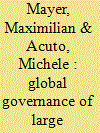|
|
|
Sort Order |
|
|
|
Items / Page
|
|
|
|
|
|
|
| Srl | Item |
| 1 |
ID:
141209


|
|
|
|
|
| Summary/Abstract |
The importance of technology in global affairs is visible to the naked and uninitiated eye. Yet International Relations (IR) still lacks a more systematic and critical attention to the role of technological infrastructures in contemporary global governance dynamics. Here, we seek to prompt IR scholars to move ‘large technical systems’ (LTSs) from the contours of IR narratives to a centre stage, as they hold the potential to respond to pressing challenges for IR scholarship. Employing LTSs to respond to recent publications on the challenge that ‘global governance’ poses to IR, we highlight that an STS-IR encounter can, first, revitalise ‘grand questions’ at the heart of IR and, second, help coping with the complexity of global governance. While this encounter does not offer a ready-tailored panacea for the troubles of IR, a more systematic inquiry into LTSs is a powerful step beyond theoretical and methodological impasses, towards greater inter-disciplinary collaboration.
|
|
|
|
|
|
|
|
|
|
|
|
|
|
|
|
| 2 |
ID:
185921


|
|
|
|
|
| Summary/Abstract |
This article challenges existing interpretations of Central Asia as a geographical entity. Adopting a history of technology approach to defining and analytically ‘constructing’ Central Asia as a region, it scrutinizes the ways the region has been materially created over the years through four types of large technical systems (infrastructures): waterways, railways, electricity grids and natural gas pipelines. This process, which is traced over a period of 150 years, can be thought of as Central Asia’s ‘hidden integration’ (and ‘hidden fragmentation’). The article maps the processes through which different parts of the region have become technically interlinked through the four systems, and Central Asia’s resulting ‘network geography’. It also studies the historical tensions, as they evolved over time, between ‘system-builders’ and ‘border-builders’.
|
|
|
|
|
|
|
|
|
|
|
|
|
|
|
|
| 3 |
ID:
115143


|
|
|
|
|
| Publication |
2012.
|
| Summary/Abstract |
This paper argues that Sweden's old and established district heating sector is heading into a stagnation phase. The aim is to analyse the factors influencing this development as well as the strategies used by involved parties to prevent stagnation. Using large technical system theory, I analyse internal and external factors potentially causing stagnation. The most obvious external factors are: an increase in the number of energy-efficient buildings, in response to stricter energy policies, which reduces the future potential for district heating in new and existing buildings; climate change; competition from other heating systems; and market saturation in the key sector, multi-dwelling buildings. The main internal factor is changed business strategies following electricity market deregulation, when energy companies were supposed to be run on businesslike terms. I also argue that stagnation can be defined as occurring when the key measure feature of a system, in this case, heat load is starting to stagnate or decline, even though the trend is positive in other areas. The strategies for avoiding stagnation are various forms of broadening scope, primarily by focusing more on electricity production by building combined heat and power plants, or using the alternative value of the technical system for new applications.
|
|
|
|
|
|
|
|
|
|
|
|
|
|
|
|
|
|
|
|
|